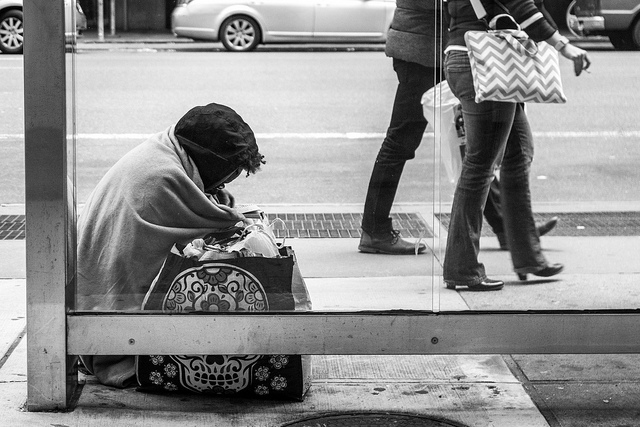
According to the Coalition for the Homeless, as of August 2017 homelessness in New York City has reached its highest levels since the Great Depression. Of the more than 61,000 people without homes, nearly 23,000 are children. During a three-month period of 2016 in just the Bronx alone, there were over 15,000 warrants of possession entered in housing court, meaning a landlord could subsequently evict the tenant. There is an invidious racial component to homelessness in New York as well. About 58 percent of shelter residents are Black and another 31 percent are Latinx.
Giselle Routhier, the policy director for Coalition for the Homeless, the nation’s oldest direct service organization assisting those without homes, describes the current situation in New York as a “lost decade.” Back in 2005, Mayor Michael Bloomberg restricted access to federal subsidies, and instead instituted a series of time-limited rental subsidies. “Between 2005 and 2014, there’s been this huge spike in homelessness as those subsidies were not working,” Routhier told Truthout. Since then, Mayor Bill de Blasio reinstated access to federal subsidies, “but the city needs much more,” she said.
In the Shadows of Riches
The New York metropolitan area is one of incredible contradiction. It simultaneously contains 33 of the richest 100 suburbs in the country, as well as the single poorest congressional district in the country. The Yankees play baseball just down the street from apartments devastated by careless landlords who fail to provide heat, cooking gas, or proper extermination services for the Bronx’s pervasive rat problem. All of this is just a 15-minute train ride into Midtown, one of Manhattan’s centers of finance and shopping. New York isn’t just a tale of two cities, it’s an absurd horror story, and it doesn’t need to be this way.
Supertall skyscrapers have started to mark New York’s skyline. Four-thirty-two Park Avenue carries the most notoriety. When construction completed, condos went on sale at a price range of $7 million to $95 million. About 80 percent of the units have sold. But instead of simply existing as a scar along the skyline, 432 Park Avenue exemplifies the reality of homelessness in New York in vulgar detail.
The tower sits mostly empty. Its purpose as a condominium is neither to house people nor is it even an occasional vacation home; its purpose is to be money storage for the wealthiest of the world. Now, instead of potentially losing millions if assets are frozen in their home countries, the rich can instead pump that money into New York City real estate, content to never call that apartment a home. A cruder term for this practice would be money laundering. Four-thirty-two Park is but one of many offending buildings along the “billionaire’s belt” south of Central Park.
Legally, you cannot sleep in Central Park at night. Police canvass it and kick out the homeless. But in the daytime hours, a strange thing occurs. Obstructed by these numerous supertalls, the sun casts shadows on the park, on homeless people seeking some amount of refuge. The homeless and the vacant buildings can both look at one another, but in New York City, never shall they meet. Four-thirty-two Park and the slew of supertall, mostly vacant apartment buildings are testaments to a city that ignores the neediest of its residents.
Income Inequality as Violence
When we talk about wealth and the poorest Americans, we oftentimes talk about rural Appalachia or the amorphous “white working class.” Rarely do we talk about New York City. That people have to walk train cars begging for change in one of the richest areas in the country should offend anything approaching common sensibility. Instead, the Metropolitan Transit Authority plays recordings telling passengers not to give out money.
Wealth does not exist in a vacuum. At some point, it becomes violence. New York City Councilmember Fernando Cabrera represents a poor part of the Bronx. In July 2017 he explained to a crowd that millionaires are rich because they can handle more pressure, that they have more to worry about, and that it’s “harder being rich than being poor.” But poverty in the Bronx means living side-by-side with disease-carrying rats. It means having babies boil alive in a homeless shelter site when a radiator bursts even though the landlord knew that it was defective.
Councilmember Cabrera thinks being rich is hard, but we know being poor is fatal. The wealthiest live 14 years longer than the poorest 10 percent.
Mayor de Blasio said that if it weren’t for private property laws protecting the kind of gross real estate practices embodied by 432 Park, we would be able to have a city that met its residents’ needs. Maybe it’s time to start considering workarounds to these laws. Vancouver rolled out an “Empty Homes Tax,” imposing a 1 percent tax on residences left vacant for at least six months. Other cities imposed similar measures, with Paris taxing second homes at 60 percent. Assuming an average price of $10 million for each apartment at 432 Park Avenue, a Vancouver-like 1 percent tax would generate an additional $10.4 million for New York City. If these homes cannot be seized for actual use for those who need it in New York, then this seems like a relatively gentle countermeasure to the violence perpetrated by the rich on those without homes that live on its streets.
Join us in defending the truth before it’s too late
The future of independent journalism is uncertain, and the consequences of losing it are too grave to ignore. To ensure Truthout remains safe, strong, and free, we need to raise $43,000 in the next 6 days. Every dollar raised goes directly toward the costs of producing news you can trust.
Please give what you can — because by supporting us with a tax-deductible donation, you’re not just preserving a source of news, you’re helping to safeguard what’s left of our democracy.